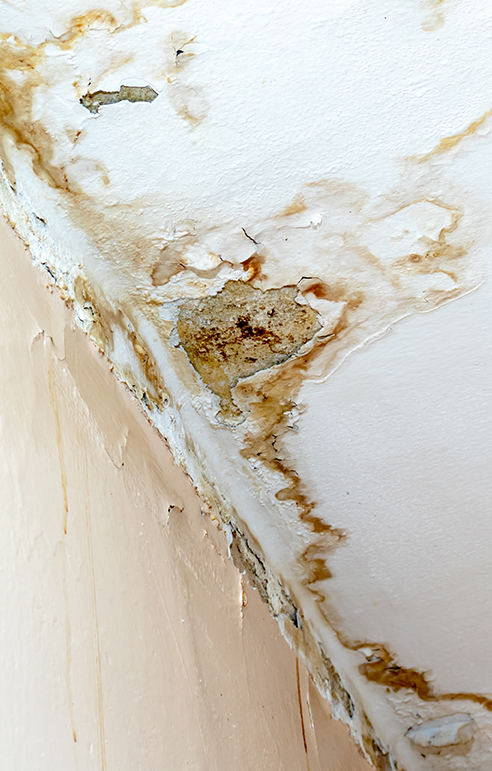A roof leak is not so obvious until you start seeing pools of water and streaks of brown on your ceiling and walls. A leaking roof is not only a danger to the health of your household, but also puts you at risk of a roof collapse and can damage your home’s interior. Below are some tips on how to effectively deal with roof leaks and prevent future problems.
Essential Steps to Take as Soon as You Realize You Have a Roof Leak
Roof leaks don’t just manifest themselves overnight. It takes time for the roof to be damaged enough to let water into your home. Some of the signs to look out for include water stains on your walls and ceiling, missing roof shingles, missing flashing, and even mold growth. However, if the water is already dripping down from your roof, here are some of the actions you can take to contain the situation:

1. Get Your Valuables Out of the Way
The first step in preventing damage to your furniture and valuable items is getting them out of the way of leakages. Move furniture, artwork, appliances, and any other valuable item to a safer part of the house away from the leaking water. Make sure you switch off the power and unplug electronics before moving them to prevent shock and fire hazards. For items that are either permanent or too heavy to move, cover them with waterproof material like plastic bags to prevent moisture damage.
2. Contain the Leaks
Lay down old rags rug or layers of newspaper to catch water on the floor if the leaks are not too big. However, for heavier leaks, a bucket should be used to collect the water dropping down from the roof. If you notice bulges in the ceiling or bubbles and blistering on the walls, they are signs of trapped water. Take a pin or any sharp object and puncture the bubbles to release the trapped water and prevent further damage.
To avoid splashing and the dripping sound, you can attach tape or string to the source of the leak so that it flows down smoothly into the collecting bucket. Vacuum water out of the carpet and promote air circulation with a fan to prevent mold growth. Proceed to clean up any remaining water and ensure everything is dry to prevent moisture from ruining your valuables. You can contact cleaning professionals to help you if there is too much water.
3. Contact Roofing Professional
Trying to repair a roof leak on your own is a dangerous undertaking that can lead to accidents and further damage to your roof. Contact a roofing expert immediately the elements subside to assess your roof and identify the cause of the leaks. This is because sometimes leakages may occur due to to plumbing issues, heating and cooling problems or mere condensation.
Your roofing contractor will then give you an estimate for the repairs that need to be done. If you are going to contact your insurance, it is important that you don’t make commitments to the repairs until you have spoken to your insurance agent. However, you can always take extra measures in case of emergencies.
4. Document the Damage and Inform Your Home Insurance Provider
If your home is insured and you plan to file for claims, you need solid proof showing the extent of damage to your roof. You, therefore, need to take pictures of the damaged areas to ease the process of filing for insurance claims. Note the date, time and weather conditions during which the leaks occurred. Your roofing expert can help you by providing important information about the extent of damage, as well as the condition of the roof and building.
5. Prevent Future Leaks
The only way to prevent future leaks is by conducting repairs or a roof replacement whenever possible. You also need to schedule routine roof maintenance to ensure that you keep your roof free of debris, pests and mold. A roof maintenance professional can also clean your gutters. Regular inspections will help you prevent future leaks and keep your roof in pristine condition for longer. Your roofing contractor will be happy to offer advice on how to ensure that your roof doesn’t leak in the future.
Is a Roof Leak an Emergency?
Roof leaks, especially when they are still small, may seem harmless. But the more you ignore them, the more they damage your roof and predispose you to a host of other problems. Here’s why you should treat a roof leak as an emergency and give it immediate attention when it happens:
- Costly Repairs. Needless to say, the more your roof leaks, the more damage it causes, both to the roof structure and the interior of your home. You will spend more on repairs and renovation of water-damaged parts of your home if you delay fixing the problem. Worse still, you may even need to replace your roof instead of just repairing it.
- Mold Growth. When moisture meets wood and it starts rotting, it encourages the growth of mold and fungi. These not only hasten the deterioration of your roof’s structure, but may also trigger or worsen respiratory problems like asthma.
- Fire Hazards. Water and electricity don’t mix. A leaking roof may cause water to come in contact with electrical wiring in your ceiling, which can cause a fire.
- High Energy Bills. A leaking roof may damage your attic insulation, reducing its efficiency. This results in high energy expenses, as you use more power to regulate your home’s temperatures.
- Structural Damage. Prolonged contact with water will damage the wood in your roof and cause it to rot. This may lead to a weakened framing and eventual roof collapse.
Don’t wait until your roof is caving in to address the situation. The earlier you tend to it, the better for both your safety and bank account.
Does Insurance Cover Roof Leaks?
Whether or not roof leaks are covered by insurance depends on the root cause of the leaks. If you have homeowner’s insurance, your roof is most likely covered against damage from the elements, such as hail and windstorms. However, insurance companies also have a bottom line to protect and won’t necessarily compensate you if your roof is old and the leaks are from wear and tear. You are also not eligible for compensation if you have neglected your roof and have not been properly maintaining it as required.
Roof leaks caused by “open perils”, which are accidents or sudden incidents, are usually covered by homeowner's insurance. It is advisable to go through your insurance company and talk to your agent to get a better understanding of what you can file claims for. This is because some insurance companies have age limits for the roofs they can reimburse, while others omit certain perils depending on the frequency of the occurrence.
Stop Roof Leaks with First Quality Roofing & Insulation
If you are experiencing a roof leak that is threatening the health of your home and household, First Quality Roofing and Insulation can help you avert impending problems. Contact us at 702-262-7847 for professional and reliable roofing solutions.
















